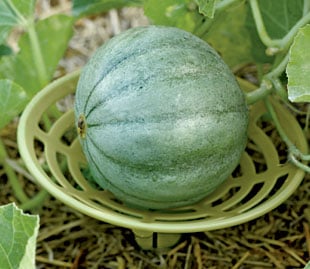Melons

Watermelon, cantaloupe, honeydew and other melons are heat-loving plants that won't tolerate frost or cold. They need warm soil to thrive. It usually takes 75 to 85 days of summer-like weather for melons to mature, but their exquisite flavor makes the wait worthwhile.
Gardeners in northern areas usually need to start their melon seeds indoors, putting three- to four-week-old plants into the garden two to three weeks after the last frost. In southern areas, melons can be sown directly into the garden as soon as the soil has warmed up.
Melons are also a little fussy about watering. They need moderate, consistent watering from germination until the fruit achieves the size of a tennis ball; then preferably no water at all until harvest.

By elevating cantaloupes, honeydews and other melons off the ground, the Melon and Squash Cradle allows air to circulate, promoting even ripening and minimizing rot.
Many gardeners mulch their melon plants with a sheet of plastic mulch to increase the soil temperature and keep the developing fruit from resting on the soil where it could rot.
When growing melons in raised beds, trellising is a good way to save space. There are a few bush melons, but most are vining types. If you grow your melons up a trellis, use strips of fabric or plastic mesh netting to support the developing fruit and prevent it from coming off the vine before it is ripe.
Toward the end of the growing season, pinch off any small melons so the larger melons will ripen and sweeten up. Each type of melon is a little different in the way it lets you know it is ripe: some slip off, some need a little tug or a twist. Some change color, others don't. Check the seed packet or plant label for clues to ripeness for the variety you are growing.
Last updated: 01/25/2021
Print this Article:
Get the Dirt
Stay up to date on new articles and advice. Please fill out the information below.
